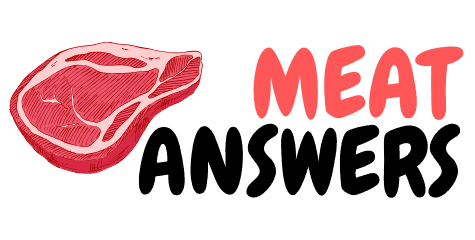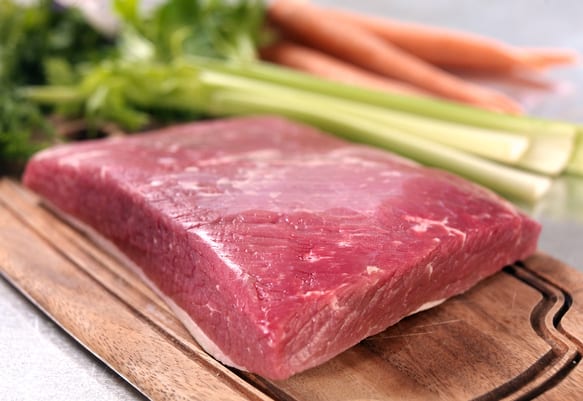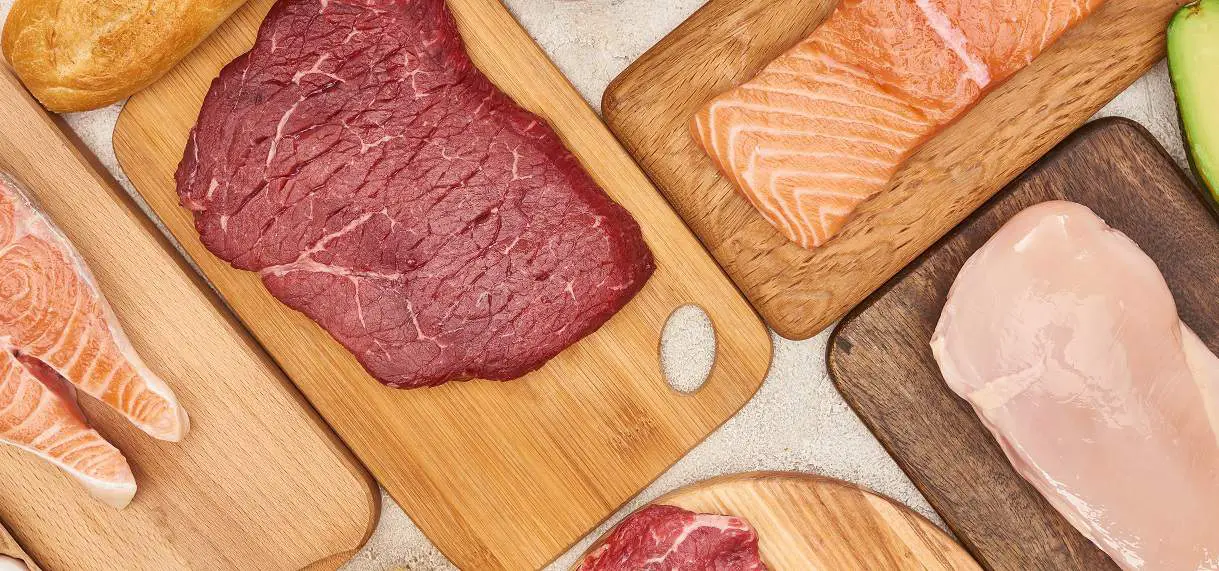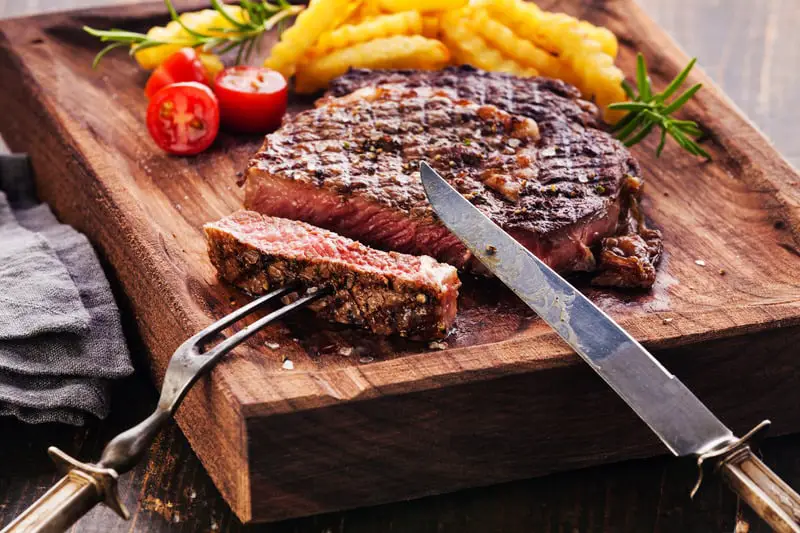Beef is the most preferred meat in America, alongside chicken and lamb. Figuring out and learning about the various cuts of meat is the best way to for you to identify them when you visit the supermarket or even cut it yourself while cooking your meat delicacy.
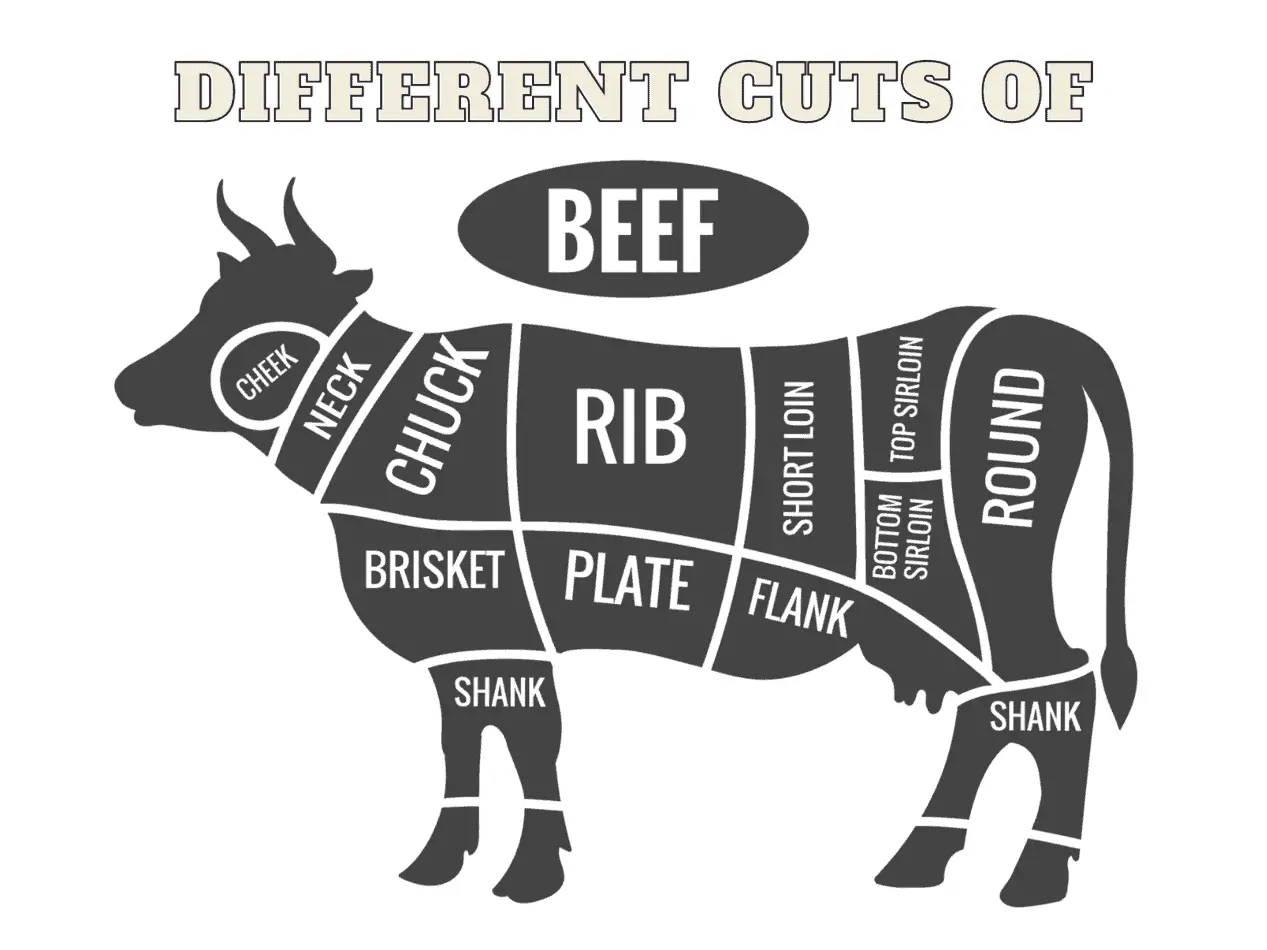
Depending on what kind of dish you want to make, there are plenty of primal cuts of meat that your nearby butcher shop or supermarket provides.
Here is what you need to know about the different cuts of meat and how to identify them, which will help you with your next shopping for a delicious dinner.
Table of Contents
What are the Primal Cuts of Meat?
There are 8 basic cuts that can be derived from one entire side of the cow. These cuts include large sections, which can undergo additional cutting to produce more number of sub-primal cuts so as to make it more flexible for cooking.
Here are the eight different primal cuts of beef.
Chuck Cut:
The beef chuck is one of the popular forms of primal cuts. The forequarter of the cow is cut down to get the chuck section. The chuck includes the cow’s upper arm near the shoulder blade, which extends towards the neck part.
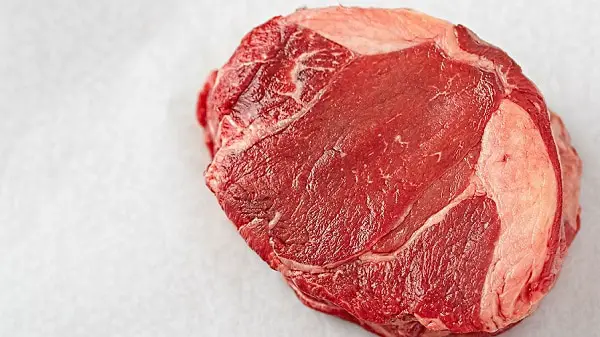
The chuck or the largest roast comes with many small muscles, which are quite easy to identify with the blade bone located at the cut’s upper center. The rib bones, along with a portion of the backbone, are also located at the lower-left part of the chuck cut. The bones are removed from the large roast before packaging.
A slicing knife helps to cut the chuck into smaller and thinner pieces. The blades can range from serrated, rounded, or blunt tips. The UltraSource – 449413 Butcher Knife can be a good choice for you to cut the chuck.
Now to cook the chuck, it is recommended to use the braise or roast method, as it makes the beef tender and flavorful. Also, you can marinate it with spices and other ingredients to enhance the flavor and taste.
The beef chuck possesses numerous connective tissues, which makes the cutting a bit tough. The chuck contains a high amount of fat, which creates a very rich flavor. This portion can be used as ground beef and serves great for roast and stews. You can opt for slow-cooking the piece to enhance its tenderness.
Now, here’s are a few sub-primal cuts of beef chuck.
- Chuck tender: The chuck tender is slender cut from where tender steak and roast can be derived. For grilling the chuck tender steak, you need to marinate it first and make it tender.
- Square-cut chuck: The square-cut chuck is soft and flavorful as it comes from marbling. It includes a variety of roasts and steaks, pectoral meat, and short ribs. Instead of putting them in a slow cooker, you can easily broil and grill the cut to obtain a palatable dish.
- Chuck roll: The chuck roll is much softer. It comes with two cuts, the under blade and chuck eye roll. This sub-primal beef cut can be cooked well to form tasty ribs, steaks, and roasts.
- Shoulder clod: This particular sub-primal cut consists of two forms of cuts, namely the shoulder clod arm roast and petite shoulder tender. Each of them is lean and filled with a marbled top layer. This beef cut can be easily slow-cooked, broiled, grilled, or smoked.
Brisket Cut:
Right below the chucks, the front part of the cow is called the brisket cut. This beef cut comes from the breast bone area of the cow. You can identify the beef brisket with its cross-sectional cut of the arm bone. It includes very small muscles, which are surrounded by connective tissues.
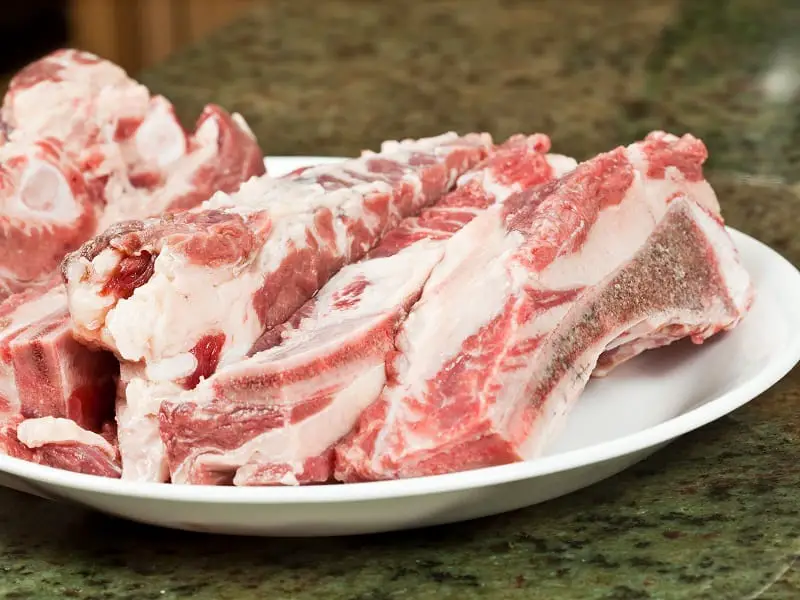
A sharp boning knife is suitable for cutting the brisket portion of the beef. The Hammer Stahl Meat Knife can be a good choice for slicing the briskets.
To cook the brisket piece of beef, it is recommended to use the braising method to retain the tenderness of the meat. You can also cook it in a liquid to get the best of the flavors.
Though the beef brisket is flavorful, it is quite tough to cut as it comes from the cow muscles, which the animal uses to perform their daily activities. Hence, slow cooking is a suitable method for cooking brisket properly until it softens.
Following are some of the sub-primal cuts of brisket beef.
- Brisket point half: The point half sub-primal cut of the brisket is full of fat and contains an exceptional flavor. You can cook it at a low temperature or slow-cook it. To enhance its tenderness, you can shred it well. It is a good option for roasting, braising, baking, or smoking.
- Brisket flat half: The flat brisket half-cut refers to the posterior part and is relatively thin. This particular cut is often known as the first-cut. You can slow cook it or try out other cooking methods like smoking, pressure-cooking, or sous vide.
Rib Cut:
The rib cut comprises the sixth cut through the 12th ribs. The rib portion does not include the lower part of the plate. The beef rib roast is a small end that includes several ribs and a portion of the backbone with one large muscle. It also consists of the rib eye.
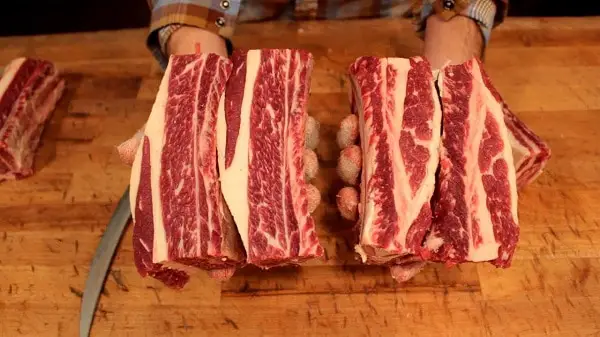
A sharp boning knife is a perfect tool to cut the tender ribs. The POKALEE Boning Knife is good to use for cutting beef ribs.
So, to cook the ribs, it is the best way to roast or grill it in indirect heat for a long time to retain all the juicy flavors in the meat.
Rib or ribeye steak is one of the most favorite cuts of all meat lovers. You can also derive the prime rib roast from the rib cut. The rib section of beef is quite tender and filled with flavors. These cuts serve multiple dishes, and thus you can easily cook them the way you want.
Now, let’s discuss the basic sub-primal cuts of beef rib cut.
- Rib sub-primal: The sub-primal cut of rib consists of the back ribs, short ribs, and rib oven-prepared, which are incredibly delicious and tender. The rib oven cut tastes best when properly roasted. And in the case of short and back ribs, there are numerous ways to cook them. The sub-primal rib cut also includes the rib fingers and lifter or blade meat.
- Ribeye roll: The ribeye roll consists of ribeye steaks and roasts, which are pretty juicy, tender, and rich in flavor. You can make scrumptious dishes out of these pieces by baking or roasting them. You can implement a variety of ways to cook steaks. You can pan-broil, grill, and smoke the steaks. The ribeye steaks are loved by all for their succulent texture and flavorful taste.
Loin Cut:
The top portion behind the rib of the cow is known as the loin. The loin section renders the superior quality of beef cuts.

The loin cut is only about 16-18 inches long, and you can yield 11-14 steaks based on its thickness. The top loin steak of beef is the first type of steak cut from the loin area. It is cut from the back end of the loin portion, which includes the 13th rib.
The center cut steaks include T-bones. And the sirloin end consists of the porterhouse steaks. The steaks are quite easy to identify with rib bone, eye muscle, and a part of the backbone.
A long carving knife is good enough for cutting the different loin sections from the meat. The MAIRICO Ultra Sharp Premium 11-inch Stainless Steel Carving Knife can be a good choice for slicing loins.
You can try baking or roasting the butts and browning their tips in a frypan for cooking the loin beef cuts. Loin portions can be cooked in multiple ways as per your choice. You can opt for grilling and pan-searing the beef cut to make a very flavorful delicacy.
The loin section comes with three sub-primal cuts and serves the most tender meat. The majority of the loin cuts are lean, yet they are tender and juicy because of their location on the steer.
- Strip loin: It is the boneless cut of the beef meat, which is filled with marbling and offers a delightful flavor. You can either roast it or subdivide it into the strip petite roast, strip steak, strip roast, or strip fillet.
- Tenderloin: The tenderloin cut refers to the long and narrow section of the meat, which is popular for being extremely succulent. The filet mignon comes from this sub-primal cut and also the tenderloin butt, tails, tips, and roasts.
- Short loin: The short loin is quite popular amongst the ones who are fond of having steak. Pieces like a porterhouse steak, loin steak tail, and T-bone steak can be obtained from this sub-primal cut. All the cuts give out a strong flavor.
Flank Cut:
Right below the loin portion, there is a good location on the cow body from where you can make boneless cuts of meat. And this area of the lower loin section corresponds to the flank cut.
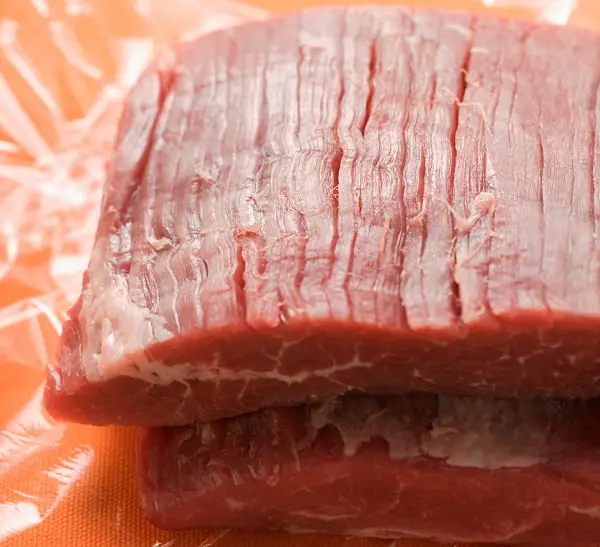
The steak derived from the beef flank is the only steak in the carcass area that constitutes an entire large muscle. The flank steak fibers run along the entire length of the steak. Hence, you can quickly identify this primal cut from its grainy texture.
A specific variation of boning knife with longer blades, also known as flank or shoulder knife, is used to cut through the flank steaks and tenderize them. You can opt for DALSTRONG – 12″ Chef’s Knife & Slicer – Gladiator Series to cut proper flank steaks.
Grilling a flank steak is the best way to prepare it. While grilling, cook it at a high temperature for a short period. Do not overcook the flank, or else it will dry out. Retain the moisture in it to get a juicy and tender texture. After cooking the steak, cut it into thin slices across the grain to enjoy a tender bite of meat.
You can obtain only one sub-primal cut from the flank beef cut, which is called the flank steak. It is also known as London broil, plank steak, or jiffy steak. The flank steak is heavily rich in flavors. You can use it as ground beef.
Besides, broiling or slicing the steak followed by stir-frying it can produce a heavenly taste. Marination and grilling of the meat with spices can enhance its taste more.
Plate Cut:
The plate portion lies below the rib cut in the forequarter of the cow. This primal beef cut is also known as the short plate. It has a lot of cartilage and is quite tough and fatty.
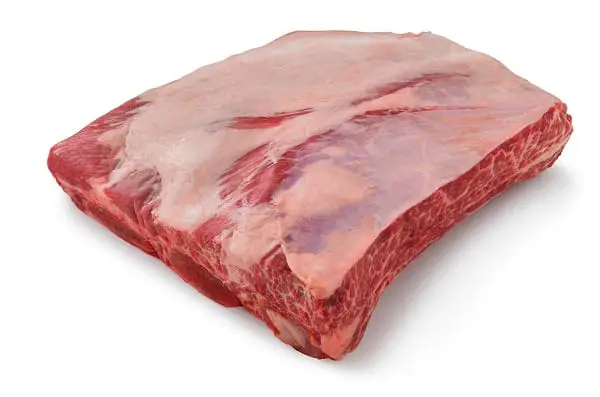
It comes from the center of the steak beneath the ribeye. When the beef rib gets serrated from the carcass, the lower portion of the ribs that remain in the beef plate comes out as the short plates.
A boning knife can be the right choice for removing the meat off the rib primal. A flexible blade can help in cutting thin pieces of beef meat. So, to get sharper cuts, you can make use of Zelite Infinity Boning Knife.
You can easily cure, smoke, or thinly slice the short plates to make palatable beef bacon. You can also try the skirt steak recipe with broiling and grilling to get the best flavor from it.
The beef plate can produce five sub-primal cuts. These sub-primal plate cuts can be cooked fast by putting them over high heat.
- Hanger steak: The hanger steak is quite thick and utterly delicious. You can make it tender by eliminating some of its connective tissues and membranes or marinate the steak thoroughly. After that, you need to broil or grill it on high heat.
- Plate short ribs: The short section of the plate’s ribs is referred to as the plate short rib. The ribs taste good when braised or grilled. You can even rub spices on the ribs to get more delicious flavors.
- Inside skirt steak: The inside skirt steak is rich in flavors and serves as a great choice for cooking fajitas or beef stir fry. To get added flavor and tender meat, you can marinate the strips for a short duration before cooking them at a high temperature.
- Outside skirt steak: This particular skirt steak is present exactly on the opposite side of the inside skirt steak. However, it seems quite alike to that of the inside skirt steak. It is widely popular in making fajitas; hence, it is tagged as fajita meat in a few instances.
- Flanken-style short ribs: The Flanken-style short ribs are also considered as the Korean-style short ribs. It is obtained by cutting through the rib bones. This sub-primal beef cut serves as a good choice for grilling; however, make sure to get it marinated first.
Round Cut:
The round primal beef cut is obtained from the cow’s back, including the rump and hind leg area.
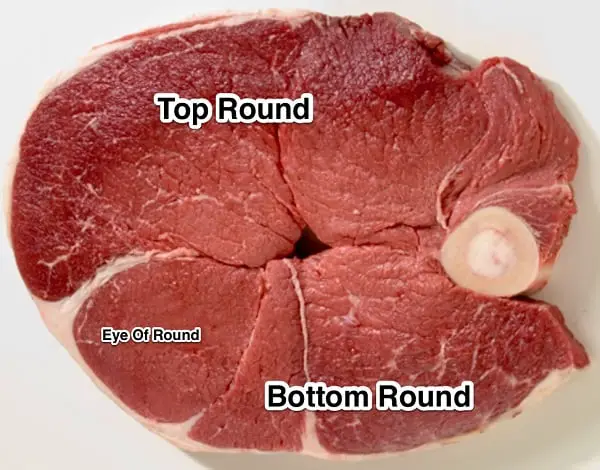
You can easily identify the round cut with its round leg bone and three muscles. At the top of the surface lies the top round. At the lower left is located the bottom round, and in the lower right, there exists the eye of the round. Many round cuts include knuckles, depending on how the round is separated from the loin area.
Cimeter or scimitar knives come with long sharp blades, which are ideal for trimming the fat off the ribs or getting a large cut from the beef. You can use the Ergo Chef Prodigy Series Cimeter Curved Breaking Knife to get those perfect rounds.
You can trim the beef and cut it into various sections to divide and flatten it to 1/4 inches of thickness. Saute the pieces with celery, onion, carrot, or other veggies until the meat becomes crisp and tender. You can also put the round beef in the microwave oven and bake it at 325 degrees for 1 hour.
The round primal cut is a bit tough. Most of the cuts from the steer near the round section are lean and contain low fat. The beef round produces some sub-primal cuts, which are delicious and goes with a variety of dishes. The cuts sometimes need a bit of marination or slow-cooking to achieve that succulent and juicy texture.
- Bottom round: The bottom round is a lean sub-primal cut derived from the exterior portion of the steer’s rear leg. The bottom round comes with two sections; one is called the outside round, which can be cut into steaks and roasts. And the other one is the heel, which can produce ground beef as well as steaks.
These cuts are best for braising or roasting and slicing. However, since the bottom round beef cut does not contain much collagen, even after braising it, you won’t get as tender meat as the braised chuck roast.
- Top round: This sub-primal cut is also known as the inside round. The top round is lean and serves as an excellent choice for sliced roast beef. You can also roast the top round to make steaks. To add more taste to the dish, you need to marinate the cut prior to cooking.
- Eye of the round: The eye of the round is extremely lean and quite similar to tenderloin. It includes an eye of round roast and an eye of round steak. It is suitable for making beef sandwiches. You can also bake or roast it and enjoy its taste.
You can marinate the round steak eye and cook it on a skillet or grill to prepare a very flavorful dish.
- Sirloin tip: The sirloin tip or knuckle comprises sirloin roast and steaks. You can grind it to obtain ground beef and use it in stews. Since the sirloin tip is too lean, you need to prepare it by roasting, braising, or baking. Do not forget to marinate them before opting for grilling or broiling.
Shank Cut:
The upper part of the cow’s legs, i.e., the portion located above the knee or hock, is considered the shank. Thus, each side of the beef comes with two shanks. One of them lies in the cow’s forequarter, and the other one is derived from the back portion.
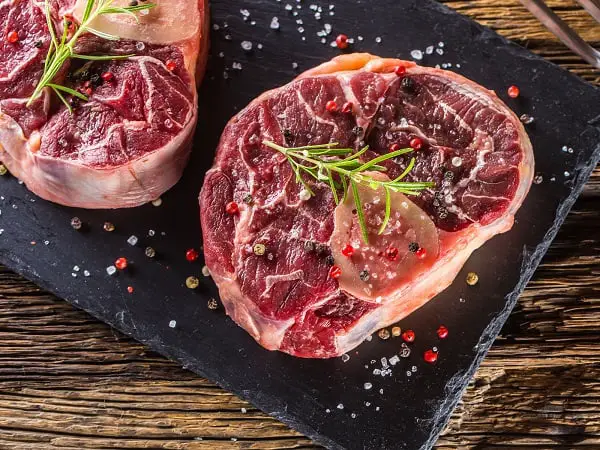
Since cows use their leg muscles for daily activities, the shank meat is quite tough and sinewy. You can easily identify a shank as it comes in a horizontal cut, often in 1-inch of slices. The beef shank seems like a steak along with a circle of leg bone at the center of each piece. At times, it is also sold boneless.
Try a serrated knife or a straight edge knife to cut the beef shank. Zelite Infinity Serrated Utility Knife 5.5 Inch can be a good pick. You can also opt for Everdure by Heston Blumenthal 8.74 Inch Santoku Knife to get a premium cutting experience.
To make the meat a bit tender before cutting it, you can marinate it with a mixture of vinegar and water for some time. It becomes easy to cut the shank when it is softer. And this is why the sub-primal cut of the shank is limited and quite expensive.
You can easily cook the beef shank at a low temperature in a slow-cooking method. It takes at least 4-6 hours to get tender and flavorful meat. You can also cook in a pressure cooker to reduce the time for cooking.
The beef shank cut produces only one sub-primal cut, which is known as the shank crosscut. The cut is lean and best for making the Italian dish, osso buco. You can braise it to get tender and succulent meat.
Conclusion:
Each of the primal beef cuts come with their own characteristics and flavors, which opens up a wide variety of cooking options for you. So, know the right cuts of meat and its suitable cooking method to cook various palatable dishes at ease.
How to make a tough cut of a meat tender?
Depending on which kind of meat cut you are using, you need to opt for a suitable cooking method, like slow-cooking, pressure-cooking, microwaving, etc. In general, for any tough cut, you can marinate the beef for a few hours before cooking to make it tender and flavorful.
You can also tenderize tough meat physically by striking it with a mallet or cutting it into thin slices before cooking or marinating it.
What type of meat cuts work best for microwave cooking?
For microwave cooking, less tender beef cuts like chuck pot roast, rolled rump roast and stew meat works the best. Microwave cooking includes the moist method. And chuck pot roast, rolled rump roast, etc., are stiffer cuts, which go better with the moist process.
On uniform heating of the beef cut, it eventually softens and releases juices rendering a unique flavor.
What is the toughest cut of beef?
The brisket cut is quite tough and used for barbecue, corned beef, or pastrami. The brisket area includes plenty of connective tissues, also known as collagen. And this makes the meat tough and hard-to-chew.
Besides, the shank refers to the steer’s leg portion, which consists of numerous muscle fibers that make it quite stiff and difficult to cut out. Hence, it is used in stews and soups and not served in any other way.
What is the most expensive cut of steak?
The rib steaks are considered to be the most expensive cut of beef steak. The Cote De Boeuf rib steak is the most expensive one ever.
The rib steaks are the most desirable meat for all beef lovers. Besides, it takes a lot of time for the butcher to present the perfect cut in the rib steaks. Additionally, it needs to be cleaned up well from all the fat. So, since it is so labor-intensive, it comes with a hefty cost.
